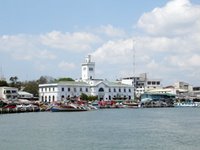 Welcoming us in Iloilo were a few colonial warehouses and the pre-war customs building. I decided to walk around the area to check out the buildings. Wow! Iloilo still had a lot of remnants of its past scattered all over the place. It would be nice to work on an urban renewal plan for Iloilo highlighting all this built heritage. I hope the HCS gets to work on it with Mayor Trenas ASAP since I feel we could replicate the Macau urban renewal success story in Iloilo!
Welcoming us in Iloilo were a few colonial warehouses and the pre-war customs building. I decided to walk around the area to check out the buildings. Wow! Iloilo still had a lot of remnants of its past scattered all over the place. It would be nice to work on an urban renewal plan for Iloilo highlighting all this built heritage. I hope the HCS gets to work on it with Mayor Trenas ASAP since I feel we could replicate the Macau urban renewal success story in Iloilo!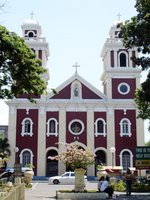 A few meters away from the port was the San Jose Church in downtown Iloilo City. The city is actually composed of several districts which include Jaro, Molo (which was the Chinatown or Parian), Villa de Arevalo (a former capital of Iloilo province which today is called as Villa for short), La Paz (most known for its batchoy), and Mandurriao.After brunch, I took a jeep to Villa and got off near the UP Visayas campus where jeeps to Miag-ao were waiting. My next destination was a UNESCO World Heritage Site, the Church of Sto. Tomas de Villanueva.
A few meters away from the port was the San Jose Church in downtown Iloilo City. The city is actually composed of several districts which include Jaro, Molo (which was the Chinatown or Parian), Villa de Arevalo (a former capital of Iloilo province which today is called as Villa for short), La Paz (most known for its batchoy), and Mandurriao.After brunch, I took a jeep to Villa and got off near the UP Visayas campus where jeeps to Miag-ao were waiting. My next destination was a UNESCO World Heritage Site, the Church of Sto. Tomas de Villanueva.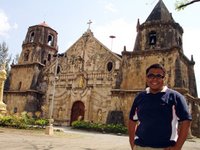 The trip took me about one hour passing through the towns of Oton (the old church of Oton was the pinnacle of religious architecture in the Philippines but was toppled by a strong earthquake in 1948), Tigbauan and Guimbal. Finally, I arrived in Miag-ao! The facade of the church was a work of art and every inch a testament to the craftsmanship of our Filipino ancestors.
The trip took me about one hour passing through the towns of Oton (the old church of Oton was the pinnacle of religious architecture in the Philippines but was toppled by a strong earthquake in 1948), Tigbauan and Guimbal. Finally, I arrived in Miag-ao! The facade of the church was a work of art and every inch a testament to the craftsmanship of our Filipino ancestors.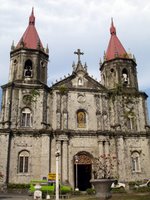 So it was back to Iloilo City to try to visit Molo, Jaro and La Paz. The church of the town after Miag-ao, San Joaquin, was another national cultural treasure. But I didn't have the luxury of time today.
So it was back to Iloilo City to try to visit Molo, Jaro and La Paz. The church of the town after Miag-ao, San Joaquin, was another national cultural treasure. But I didn't have the luxury of time today.
At least Molo was along the way to downtown. So I got off at Molo to check out some churches and houses. I would say that Molo Church is a symbol of feminism because it is a shrine to female saints. The Church of Sta. Ana has on nine statues of female saints on either side of the church, one on every column. At the center retablo is Sta. Ana, mother of Mary. The houses left standing around the area were stunning as well.With Molo done, it was off to Jaro. But traffic was moving really slow. And by 4 p.m., I was still in the public market so I decided not to push through since I could be left behind by the last ferry which left at 5:30 p.m. So I checked mail to kill time. Watching the sun set behind the customs building was just enchanting. On the way back, I took photos of Guimaras Island. Seeing the island, green and untouched, made me realize that the country still had hope if we took care of what was left of it.
Watching the sun set behind the customs building was just enchanting. On the way back, I took photos of Guimaras Island. Seeing the island, green and untouched, made me realize that the country still had hope if we took care of what was left of it.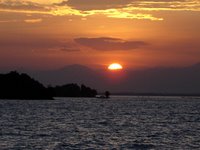 I got back in Bacolod at about 6:30 p.m. Near the cathedral was an area called manukan country, which was a cluster of restaurants ans stalls which served Bacolod's famous chicken inasal. And when in Bacolod, you must try the chicken!I leave for Manila tomorrow. But I have only last stop before going home, the Paris of Negros.
I got back in Bacolod at about 6:30 p.m. Near the cathedral was an area called manukan country, which was a cluster of restaurants ans stalls which served Bacolod's famous chicken inasal. And when in Bacolod, you must try the chicken!I leave for Manila tomorrow. But I have only last stop before going home, the Paris of Negros.
Check out this Inquirer article which came out today for my two seconds of fame! Hehe!
Ang indi makahibalo magbalikid sa iya nga ginhalinan, indi makalab-ot sa iya padulungan. Some refer to it as the national proverb and yet few Filipinos ever put it to heart. That's the Hiligaynon translation. The moment I got off the tricycle in front of our house in Bacolod, I knew I was home.It was refreshing seeing a familiar place although I've been there only thrice in my life and not in the past ten years. As I opened the gate, I felt a surge of energy. Walking around brought back memories more so as I looked at a photo of myself as a kid on the walls of one of the rooms. My grandparents died a few months apart in September 2002 and February 2003. I never got to attend their wakes since for some reason, I was out of the country when it happened. It's a coincidence that they died a few months apart since they were born just two months apart as well.Tired from the non-stop travel, I went straight to bed.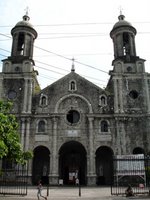 I woke up the next day to catch the ferry to Iloilo City. I had wanted to see Iloilo for the longest time and now that I was in Bacolod, this was my chance. But before that, I walked to the Cathedral of Bacolod which was on the same street as our house, to take photos.Bacolod is called the City of Smiles. Just like the City of San Fernando in Pampanga, Bacolod City is the capital of a rich sugar-producing province, Negros Occidental. It's also a coincidence that both my mom and my dad are from sugar-producing provinces.
I woke up the next day to catch the ferry to Iloilo City. I had wanted to see Iloilo for the longest time and now that I was in Bacolod, this was my chance. But before that, I walked to the Cathedral of Bacolod which was on the same street as our house, to take photos.Bacolod is called the City of Smiles. Just like the City of San Fernando in Pampanga, Bacolod City is the capital of a rich sugar-producing province, Negros Occidental. It's also a coincidence that both my mom and my dad are from sugar-producing provinces. According to oral tradition, the Henares clan were weavers from Iloilo. During the middle of the 19th Century, there was an exodus of migrants from Iloilo to the sparsely-populated island of Negros due to a boom in sugar production. Having been orphaned, the siblings led by Mateo, my great-great grandfather, and his brother Esteban, joined the migration to Negros and upon arriving, armed only with the knowledge of the Spanish language, secured a loan that would serve as capital for what would become a plantation in Talisay.
According to oral tradition, the Henares clan were weavers from Iloilo. During the middle of the 19th Century, there was an exodus of migrants from Iloilo to the sparsely-populated island of Negros due to a boom in sugar production. Having been orphaned, the siblings led by Mateo, my great-great grandfather, and his brother Esteban, joined the migration to Negros and upon arriving, armed only with the knowledge of the Spanish language, secured a loan that would serve as capital for what would become a plantation in Talisay. To make the long story short, the venture boomed. Mateo managed the plantation in Talisay while Esteban took care of business in Bacolod. The brothers were able to build their homes in an area along what is now Rizal Street. This area during the early post-war years was fondly referred to as Henares block since everyone in the block was a Henares. As a result of this hardwork, they were able to send their children to the best schools in Manila, among whom were my great-grandfather Pedro G. Henares (UP College of Medicine, 1915; Bacolod's first health officer, 1917 to 1919; and municipal councilor, 1925 to 1928), and his younger brother Hilarion G. Henares, Sr. (UP College of Engineering, 1917; and a government pensionado), the father of journalist and former cabinet secretary Larry Henares. Esteban Henares even became municipal president (mayor) of Bacolod from 1913 to 1916. Well, that's a little bit of family history and I'll stop here lest I bore you. Hehe!From the cathedral, I took a pedicab to the pier since it was in the reclamation area, quite far for a walk and since no jeeps passed that area. There were a lot of fast ferries available and I picked the one that would bring me there the fastest. Hehe! The student fare on Ocean Jet is PHP221 one-way. Hmmm, I didn't expect it to cost that much for such a short trip. Well, you get what you pay for. The seats were in good condition and they get you there in exactly an hour.
To make the long story short, the venture boomed. Mateo managed the plantation in Talisay while Esteban took care of business in Bacolod. The brothers were able to build their homes in an area along what is now Rizal Street. This area during the early post-war years was fondly referred to as Henares block since everyone in the block was a Henares. As a result of this hardwork, they were able to send their children to the best schools in Manila, among whom were my great-grandfather Pedro G. Henares (UP College of Medicine, 1915; Bacolod's first health officer, 1917 to 1919; and municipal councilor, 1925 to 1928), and his younger brother Hilarion G. Henares, Sr. (UP College of Engineering, 1917; and a government pensionado), the father of journalist and former cabinet secretary Larry Henares. Esteban Henares even became municipal president (mayor) of Bacolod from 1913 to 1916. Well, that's a little bit of family history and I'll stop here lest I bore you. Hehe!From the cathedral, I took a pedicab to the pier since it was in the reclamation area, quite far for a walk and since no jeeps passed that area. There were a lot of fast ferries available and I picked the one that would bring me there the fastest. Hehe! The student fare on Ocean Jet is PHP221 one-way. Hmmm, I didn't expect it to cost that much for such a short trip. Well, you get what you pay for. The seats were in good condition and they get you there in exactly an hour.
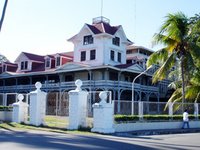 I finally stepped foot in the City of Gentle People. It was said that Dr. Jose P. Rizal himself created this nickname for Dumaguete City during his brief stopover in the town on August 1, 1896 en route to Dapitan. I arrived in Dumaguete at 4 p.m. after a quick trip via fast craft from Siquijor. Right by the port were the famous buildings of Silliman University. After taking a few photos, my SSEAYP batchmate Tere Sicat arrived at the port and took me around town. We first went to the neighbring town of Bacong where another national cultural treasure could be found, the San Agustin Church.
I finally stepped foot in the City of Gentle People. It was said that Dr. Jose P. Rizal himself created this nickname for Dumaguete City during his brief stopover in the town on August 1, 1896 en route to Dapitan. I arrived in Dumaguete at 4 p.m. after a quick trip via fast craft from Siquijor. Right by the port were the famous buildings of Silliman University. After taking a few photos, my SSEAYP batchmate Tere Sicat arrived at the port and took me around town. We first went to the neighbring town of Bacong where another national cultural treasure could be found, the San Agustin Church.
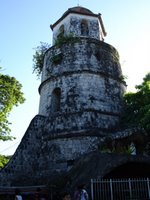 It was about thirty minutes south of Dumaguete. On the way to Bacong, we passed by the Dumaguete belltower and several Gabldon schoolbuildings to take photos. When we got there, the first thing I noticed was the charming presidencia in front of a wide lawn, typical of many Negros towns and cities.
It was about thirty minutes south of Dumaguete. On the way to Bacong, we passed by the Dumaguete belltower and several Gabldon schoolbuildings to take photos. When we got there, the first thing I noticed was the charming presidencia in front of a wide lawn, typical of many Negros towns and cities.
 It was quite a while before we got in the church since we had to look for the key. But when we entered, I thought it was not that much impressive for a national cultural treasure. It had an old pipe organ and well-preserved retablos but that was it. I wonder how this church got chosen for the list of 26 but nevertheless, that was fine with me. But just to clarify, there are more than 26 national cultural treasures. Others got declared during the time of Marcos.
It was quite a while before we got in the church since we had to look for the key. But when we entered, I thought it was not that much impressive for a national cultural treasure. It had an old pipe organ and well-preserved retablos but that was it. I wonder how this church got chosen for the list of 26 but nevertheless, that was fine with me. But just to clarify, there are more than 26 national cultural treasures. Others got declared during the time of Marcos.
 After Bacong, we went back to Dumaguete to stroll down the "boulevard" along the sea. You've never been to Dumaguete if you haven't strolled down the promenade beside Rizal Boulevard. It was a great view since to your left, you could see the island of Cebu, while Siquijor was to your right. It just shows how close the islands of the Visayas are to each other. It's funny though how sand along the Negros coastline was mostly gray when it's neighbors had a lot of white sand.
After Bacong, we went back to Dumaguete to stroll down the "boulevard" along the sea. You've never been to Dumaguete if you haven't strolled down the promenade beside Rizal Boulevard. It was a great view since to your left, you could see the island of Cebu, while Siquijor was to your right. It just shows how close the islands of the Visayas are to each other. It's funny though how sand along the Negros coastline was mostly gray when it's neighbors had a lot of white sand.
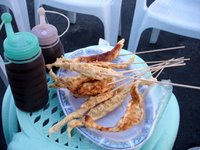 I really liked the lamp posts. It was good that they were able to preserve them. Along the road, you could see nice pre-war homes and even a hotel that was restored to its original grandeur.
I really liked the lamp posts. It was good that they were able to preserve them. Along the road, you could see nice pre-war homes and even a hotel that was restored to its original grandeur.
Another must do in Dumagute is a visit to the tempurahan at the end of the boulevard. Again, it's another you-haven't-been-to- Dumaguete kind of thing which one should include in a trip.
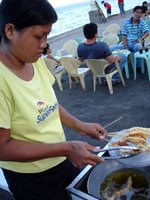 It may be called tempura because it is shaped like the Japanese fried shrimp dish. But it tasted more like kikiam to me. You had neatly arranged carts, seats and tables lined up in clean rows and columns. Each was sold for PHP3 a piece. They also had squidballs as well as balut and penoy for sale. I really look for these places everytime I travel thanks to my friends in Singapore and Malaysia who went out of their way to let me have a taste of the best hawker food when I was there.
It may be called tempura because it is shaped like the Japanese fried shrimp dish. But it tasted more like kikiam to me. You had neatly arranged carts, seats and tables lined up in clean rows and columns. Each was sold for PHP3 a piece. They also had squidballs as well as balut and penoy for sale. I really look for these places everytime I travel thanks to my friends in Singapore and Malaysia who went out of their way to let me have a taste of the best hawker food when I was there.
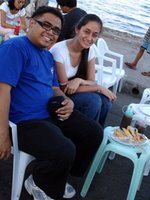
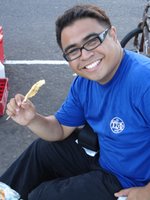 They told me that when they came to the Philippines, they also wanted to eat hawker food which didn't get a good response from me obviously since I didn't want to bring any of my guests to the hospital. Haha! At the moment, the only safe place for hawker food I know in Manila is UP Diliman. For some reason, I feel it's safer eating hawker food in the provinces. After that tasty snack, it was off to Teresa's house for dinner.
They told me that when they came to the Philippines, they also wanted to eat hawker food which didn't get a good response from me obviously since I didn't want to bring any of my guests to the hospital. Haha! At the moment, the only safe place for hawker food I know in Manila is UP Diliman. For some reason, I feel it's safer eating hawker food in the provinces. After that tasty snack, it was off to Teresa's house for dinner.
They prepared a lot of food. Really great! We didn't have much time to chat since I was after the last bus to Bacolod which left at 7:30 p.m. It was midnight again when I arrived in my dad's hometown.
 Welcoming us in Iloilo were a few colonial warehouses and the pre-war customs building. I decided to walk around the area to check out the buildings. Wow! Iloilo still had a lot of remnants of its past scattered all over the place. It would be nice to work on an urban renewal plan for Iloilo highlighting all this built heritage. I hope the HCS gets to work on it with Mayor Trenas ASAP since I feel we could replicate the Macau urban renewal success story in Iloilo!
Welcoming us in Iloilo were a few colonial warehouses and the pre-war customs building. I decided to walk around the area to check out the buildings. Wow! Iloilo still had a lot of remnants of its past scattered all over the place. It would be nice to work on an urban renewal plan for Iloilo highlighting all this built heritage. I hope the HCS gets to work on it with Mayor Trenas ASAP since I feel we could replicate the Macau urban renewal success story in Iloilo! A few meters away from the port was the San Jose Church in downtown Iloilo City. The city is actually composed of several districts which include Jaro, Molo (which was the Chinatown or Parian), Villa de Arevalo (a former capital of Iloilo province which today is called as Villa for short), La Paz (most known for its batchoy), and Mandurriao.
A few meters away from the port was the San Jose Church in downtown Iloilo City. The city is actually composed of several districts which include Jaro, Molo (which was the Chinatown or Parian), Villa de Arevalo (a former capital of Iloilo province which today is called as Villa for short), La Paz (most known for its batchoy), and Mandurriao. The trip took me about one hour passing through the towns of Oton (the old church of Oton was the pinnacle of religious architecture in the Philippines but was toppled by a strong earthquake in 1948), Tigbauan and Guimbal. Finally, I arrived in Miag-ao! The facade of the church was a work of art and every inch a testament to the craftsmanship of our Filipino ancestors.
The trip took me about one hour passing through the towns of Oton (the old church of Oton was the pinnacle of religious architecture in the Philippines but was toppled by a strong earthquake in 1948), Tigbauan and Guimbal. Finally, I arrived in Miag-ao! The facade of the church was a work of art and every inch a testament to the craftsmanship of our Filipino ancestors. So it was back to Iloilo City to try to visit Molo, Jaro and La Paz. The church of the town after Miag-ao, San Joaquin, was another national cultural treasure. But I didn't have the luxury of time today.
So it was back to Iloilo City to try to visit Molo, Jaro and La Paz. The church of the town after Miag-ao, San Joaquin, was another national cultural treasure. But I didn't have the luxury of time today. Watching the sun set behind the customs building was just enchanting. On the way back, I took photos of Guimaras Island. Seeing the island, green and untouched, made me realize that the country still had hope if we took care of what was left of it.
Watching the sun set behind the customs building was just enchanting. On the way back, I took photos of Guimaras Island. Seeing the island, green and untouched, made me realize that the country still had hope if we took care of what was left of it. I got back in Bacolod at about 6:30 p.m. Near the cathedral was an area called manukan country, which was a cluster of restaurants ans stalls which served Bacolod's famous chicken inasal. And when in Bacolod, you must try the chicken!
I got back in Bacolod at about 6:30 p.m. Near the cathedral was an area called manukan country, which was a cluster of restaurants ans stalls which served Bacolod's famous chicken inasal. And when in Bacolod, you must try the chicken!










